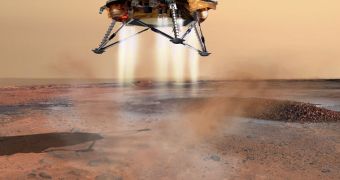Researchers at NASA have just been awarded new funds to study data that has been collected by the space agency's Phoenix Mars Lander before the harsh conditions on Mars subdued it.
Engineers at the Jet Propulsion Laboratory (JPL), in Pasadena, California, who managed the lander's mission, lost contact with the spacecraft back in November 2008.
When the Martian winter began, the amount of sunlight hitting Phoenix's solar panels became insufficient to allow for normal functioning. The machine therefore shut down entirely.
Experts had hopes that it would come back online due to a built-in Lazarus mode, but that hope proved to be useless. The robot continues to appear dead on the surface of Mars.
At the beginning of 2010, researchers conducted a series of listening campaigns using the NASA Mars Odyssey orbiter, which were aimed at picking up potential signals from the lander. The efforts failed.
Subsequent images of the robot showed extensive damage to its solar panels, which means that it cannot possible recover the levels of energy required to activate the Lazarus mode.
But the spacecraft may continue to produce science even from beyond the grave, say researchers at University of Arkansas in Fayetteville, quoted by Space.
Experts here, led by Arkansas Center for Space and Planetary Sciences research professor Vincent Chevrier, announce they have just received new funds from NASA to analyze datasets gathered by Phoenix.
The team will look especially at how dirt and sand on Mars interact with the planet's atmosphere, and also at whether these complex interactions may at any time favor the formation of water.
“Our group has shown that it is thermodynamically possible to have a stable liquid in the soil for a few hours a day under certain conditions. The effect of the regolith, or soil, on the water cycle is poorly understood and the Phoenix data provide a unique insight into these processes,” says Chevrier.
The expert adds that, at this point, existing models accounting for the events going on in the Martian atmosphere are mediocre and basic at best.
Utilizing the Phoenix data could lead to the development of more advanced models, that would allow for better planning in the event of a mission to the Red Planet.
Additionally, the models could also shed some light on how Mars looked like millions to billions of years ago, when researchers say liquid water was present on its surface.

 14 DAY TRIAL //
14 DAY TRIAL //